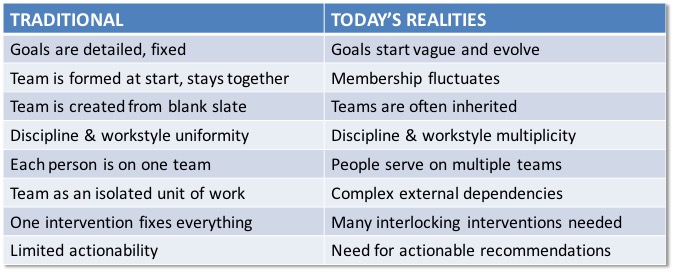
Everything you know about teams is wrong? Perhaps not today but it will be soon. My first ideals of a team came from my experience in the sports arena. I played football in England and I was part of the local boys team. We had a group of 13 lads and that was it. The group composition was static, we know who was playing and we knew who we were playing against. We each filled positions on the field and knew what we were expected to do. It didn’t change much from game to game and our goal was to win as many games as possible, to win the league.
When I moved into the corporate world, teams were a little more dynamic, but not much. Their composition changed more often but we still had a very stable core group. I remember having a stack of organization charts to understand who was on what team. They didn’t change very often. Projects came and went, and they involved forming smaller shorter duration teams. These project teams included the usual people and they lasted for many months.
Even though we are familiar with these stable teams, it is dangerous to assume this is what a team is. Last week, I delivered a couple of workshops with Herman D’Hooge as part of Design Week Portland. We have a deep understanding of team performance, and in preparation for these workshops, we researched what makes a design team unique. Even though we didn’t discover everything we know is wrong. We did notice the acceleration of some important disruptive trends.
Disruptive trends
- Working across boundaries is the norm. This includes working across disciplines and working across company boundaries. This means working across cultures. Design is challenging in itself, being a blend of science and art.
- Team composition is highly dynamic. Team members change frequently, and who is on the team is not clear. Is a critical contributor who has one day of work on a six month team a member?
- Teams goals are constantly shifting and are often not well defined when the team is formed.
- Creativity and innovation need positive team conflict. In most teams I’ve worked with, conflict is seen as a negative, to be avoided at all costs.
- People are on multiple teams. Mark Mortensen notes some people work on as many as fifteen teams concurrently.
Each of these trends debunk the assertion that teams are stable operating units. These changes are summarized in the chart below from our Design Week Portland workshop:
These trends are accelerating
Seeking ever increasing amounts of value will exacerbate these characteristics. So how do we manage in future? The success of these ‘new’ teams will be significantly affected by the relationships between team members. These are the one on one and collective relationships. A key role of the team leader is to establish and maintain an environment where these relationships can thrive. Amy Edmondson describes four key leadership behaviors for managing extreme teams:
- Build an engaging vision
- Cultivate psychological safety
- Develop shared mental models
- Empower agile execution
I talked about establishing psychological safety in my last post. You can access a guide about how to cultivate psychological safety below. This blog will address the other topics in coming weeks.


